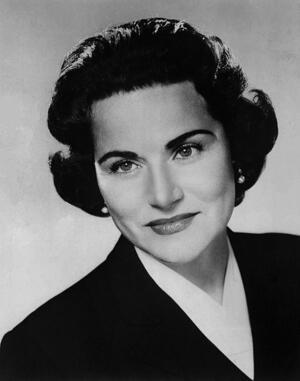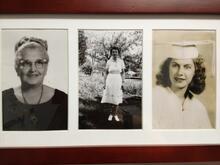Abigail Van Buren
Born Pauline Friedman, Abigail Van Buren was best known for her “Dear Abby'' column and the witty, commonsense advice she gave hundreds of millions of readers. In 1955, Van Buren wrote to the editor of the San Francisco Chronicle to offer her services as an advice columnist, choosing her pen name from the biblical figure whom King David praised for her wise counsel. In her column, she championed the rights of women, Jews, African Americans, and other groups, occasionally publishing columns that newspapers threatened not to print, such as one where she advocated women’s rights to control their own bodies. In addition, she wrote six books. As she began to suffer from Alzheimer’s, Van Buren co-wrote her column with her daughter Jeanne.
In 1990 alone, advice columnist “Dear Abby” and her staff received over fifty-five thousand letters from men and women of all ages, classes, nationalities, sexual orientations, and religions. With a clear, witty, and informative writing style and a readership of 150 to 200 million, Pauline Esther Friedman Phillips, known professionally as Abigail Van Buren or Dear Abby, influenced American life and culture since the inception of her column in the mid-1950s. Openly revealing her opinions concerning antisemitism, sexism, and racism while responding to her readers’ diverse queries, Dear Abby actively championed Jewish and non-Jewish women’s rights both in the United States and internationally.
Pauline’s parents, Abraham and Rebecca Friedman, were Russian Jewish immigrants who arrived in the United States in 1908. They moved to Sioux City, Iowa, in 1910, giving birth to Helen and then Dorothy soon after. Like many Russian Jewish immigrants of that time, the family slowly earned enough money to leave the poorer sections of the city, first by peddling chickens from a pushcart and then, by 1911, by amassing enough earnings to buy into a grocery store. When Pauline was born, her parents owned a small house. Her father became part owner of a movie and vaudeville theater when she was in her early teens. Active in the Jewish community of Sioux City, Abraham Friedman’s civic stature grew as he acquired other theaters and diversified his business interests.
Nicknamed “Popo,” Pauline was born on July 4, 1918, only seventeen minutes apart from her twin, Esther Pauline (later known as columnist Ann Landers). The two girls shared similar interests, dressed in like styles, attended the same high school (Central High School, from which they graduated in 1936), and matriculated at the same small college nearby. Pauline met her future husband, Mort Phillips, at a University of Minnesota dance. Mort Phillips’s father, like the girls’ father, was a Russian Jewish immigrant, born in Minsk. Just as the twins had experienced other important events simultaneously, soon after Pauline became engaged, Esther met her future husband, Jules Lederer. The sisters had a double wedding on July 2, 1938, at their synagogue in Sioux City. The Phillipses had two children, Jeannie and Eddie.
The name change that launched her career
When the Phillipses moved to Hillsborough, California, from Eau Claire, Wisconsin, in 1955, Pauline contacted an editor with the San Francisco Chronicle to express her displeasure with their newly established Molly Mayfield lovelorn column. She offered the Chronicle a radical departure from the paper’s previous features. Her column was to be humorous, helpful, and filled with one-liners. The paper hired her and she rapidly became a success, adopting the name Abigail Van Buren. Pauline contracted for the rights to the names Abigail Van Buren and Dear Abby, a move that gave her great control over her column and a large share of its profits.
For several decades, Abigail Van Buren counseled her readership, as well as shared with them her political, moral, and social views. Championing the rights of women, Jews, African-Americans, and others, she published advice columns that newspapers have threatened not to print. On July 29, 1991, for example, she reissued a letter in favor of women’s rights to control their bodies, even though a number of papers threatened not to run it.
Because she became Dear Abby three months after her twin assumed the Ann Landers column, the sisters attempted to curb any acrimony between them by agreeing not to vie for the same city’s newspaper. However, their competition intensified after Ann Landers signed a one-year contract with the Sun Times and appeared on What’s My Line?. In 1956, Abigail Van Buren allegedly offered “Dear Abby” at a reduced rate to the twins’ hometown paper, Sioux City Journal, as long as it promised not to run “Ann Landers.” Life magazine informed the public of their acrimony in April 1958. Although the sisters publicly reconciled in 1964 for their twenty-fifth wedding anniversaries, their competition continued. As she began to suffer from Alzheimer’s, her daughter, Jeanne, took on more duties of the column.
Van Buren’s legacy
Abigail Van Buren lived in Sioux City, Eau Claire, Los Angeles, and at the end of her life in Minneapolis. In all these locations, she remained active in citywide and national Jewish and non-Jewish organizations. Volunteering with synagogues, old age homes, the American Society for AIDS Research (AmFar) and the Jewish National Fund, her largest contribution may have been her ability to make public issues of concern to Jewish and non-Jewish women.
She died of Alzheimer's Disease in Minneapolis on January 16, 2013.
Pottker, Jan. Dear Ann, Dear Abby: The Unauthorized Biography of Ann Landers and Abigail Van Buren (1987).
“Queen of Hearts.” Psychology Today 26 (May/June 1993): 56–60+.
Rottenberg, Dan. “Ann and Abby’s Lessons for Journalists.” The Quill 72 (January 1984): 20–24.





